
What are pelvic varicose veins?
Causes of pelvic vein dilation
- Pelvic venous valve insufficiency - they are supposed to allow blood to flow only toward the heart, but if the valve mechanism fails, some blood can back up;
- Pelvic blood vessel obstruction (blockage, blockage);
- Hormonal changes in women increase the permeability of vein walls.
- Endometriosis;
- Sitting or standing for long periods of time (resulting in stagnant blood flow to the pelvic organs);
- Innate structural characteristics of blood vessels.
Symptoms of pelvic venous dilation
- Varicose vein syndrome.It manifests as marked dilation of the vulvar and perineal blood vessels. In addition, some women develop enlarged veins in their buttocks, pubic bone, and groin. The labia may become swollen at the end of the day.
- Pain syndrome.Varicose veins in the small pelvis have dilated blood vessels, which become a major reason to see a doctor and undergo treatment. Pain Characteristics: Persistent, painful, located in the lower abdomen (related to the uterus) and radiating to the thighs and perineum. The pain worsens with physical activity and when the body is still for long periods of time. They decrease after resting in a horizontal position. Pain may worsen during the second phase of the menstrual cycle, which is related to hormonal changes.
- Pelvic organ dysfunction.Most commonly, the menstrual cycle is disrupted due to pelvic varicose veins. The second most common syndrome in this group is dyspareunia. This is pain that occurs during or after sexual intercourse. They are associated with overflow of blood from the venous beds of the pelvic organs. Pain may last from half an hour to a day after exposure. The third most common symptom is difficulty urinating. There is usually increased urination and, rarely, urinary incontinence.
- Psycho-emotional disorders.They are caused by long-term pain and reduced quality of sexual life. Depression occurs in most cases.
Diagnosis of varicose veins
- X-ray contrast - pelvic venography and selective ovaryography.
- CT and MR venography are diagnostic methods that provide more information than traditional X-rays. In addition, they are less invasive: Contrast material can be injected into the cubital vein, and MRI can provide a wealth of information even without the use of contrast material.
- Radionuclide technology.
Conservative treatment of varicose veins
- Medications to treat varicose veins in the small pelvis;
- compression jersey;
- Herbal medicines (most medications for treating small pelvic varicose veins are plant-based);
- physiotherapy;
- physiotherapy.
Surgical treatment of pelvic venous dilatation
Intervention on perineal blood vessels
Intervention on gonadal vessels
Interventions in the kidneys and iliac vessels
where to
Causes of pelvic varicose veins
- Sedentary, sedentary lifestyle;
- "Aorto-mesenteric forceps" syndrome;
- pregnancy and delivery history;
- genetic susceptibility;
- Congenital anatomical features of the renal vein;
- Endometriosis;
- Injuries to the pelvic area, etc.
Treatment of varicose veins in the small pelvis in women
Causes of pelvic varicose veins
Clinical treatment of small pelvic varicose veins
With the help of special instruments, special spirals are installed into the venous cavities to prevent improper blood flow, which can lead to pelvic varicose veins
- pelvic discomfort
- heaviness in pelvis
- Pain in the pelvis
- Physical exercise
- standing and sitting for long periods of time
- pregnancy and childbirth
- Pelvic trauma
- Uterine and ovarian tumors
- endometriosis
- Indications for embolization therapy are:
- Pelvic varicose veins and chronic pelvic pain syndrome
- Dysmenorrhea
- External genital varicose veins
- pain during intercourse
Symptoms of pelvic varicose veins in men and women
- Persistent dull pain in lower abdomen;
- Pain in the sacrum and coccyx area;
- lower back and groin pain;
- Frequent urination;
- urinary incontinence;
- False urge to empty the bladder.
Pelvic varicose veins and their treatment
What are pelvic varicose veins?
What are pelvic varicose veins
Why do pelvic varicose veins occur?
- The growing uterus during pregnancy puts pressure on blood vessels;
- weightlifting and other physical activities;
- Sedentary jobs, sedentary lifestyles;
- Gynecological diseases: ovarian inflammation, endometriosis;
- Erratic menstrual cycle;
- Hormonal imbalances and treatment with estrogen-containing medications;
- Congenital anomalies of blood vessel walls;
- Lack of orgasm or protection from frequent interruptions in intercourse.
Types of minor pelvic varicose veins
- Primary, caused by congenital or acquired dyspareunia
- Advanced varicose veins in the small pelvis can cause symptoms such as swollen veins in the groin, thighs, and buttocks. Manual examination may also reveal venous nodules.
Treatment of varicose veins
Measures to prevent varicose veins in the small pelvis
- Moderate physical activity: walking, exercising. Moving muscles keeps blood flowing in your veins, which is why exercise is important.
- If you need to sit or stand at work, try taking a break every 30 minutes to move around. For example, take a walk, put on the kettle, carry something to the shelf.
- Women are advised to avoid strenuous and excessive physical activities: swings, lifting weights and overcoming incredible distances. Such a load is unnatural for the female body.
- Stick to your drinking habits. Adults need 30ml per 1kg per day.
- Eat well and drink well. Eat more vegetables and fruits. Eat less fast food, greasy, floury and spicy foods.
- Consult a phlebologist and perform a series of exercises at home.


















